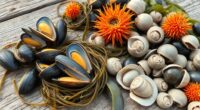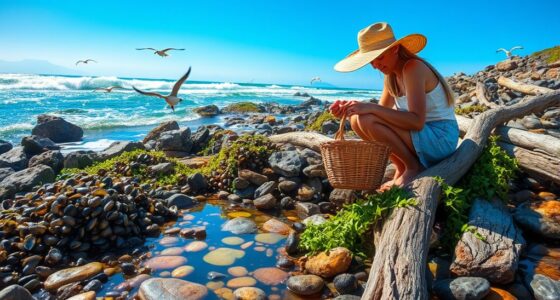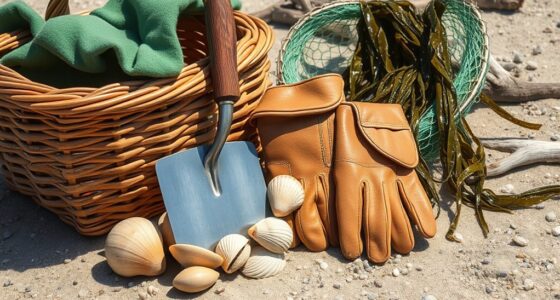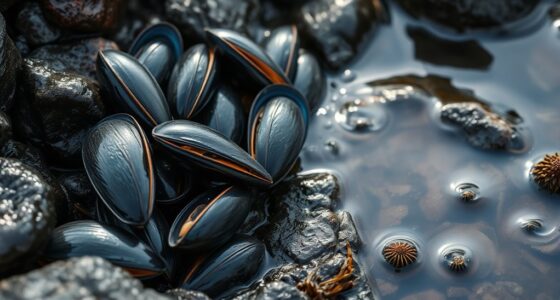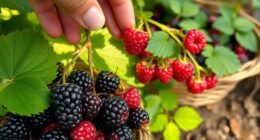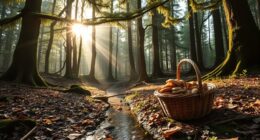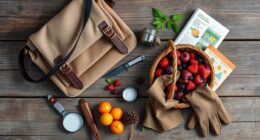When coastal foraging, you should respect delicate marine ecosystems by harvesting sustainably, limiting your pickings, and avoiding protected habitats like eelgrass beds and dunes. Practice responsible collection by only taking what you need and leaving reproductive parts intact. Always follow local regulations and obtain permits when needed. Keep disturbance to a minimum, minimize impact on wildlife, and pack out all trash. Continuing will guide you through essential ethics and tips to foraging responsibly in coastal areas.
Key Takeaways
- Respect protected habitats by avoiding sensitive areas and obtaining necessary permits before foraging.
- Harvest only small amounts, focusing on mature, reproductive plant parts to prevent overharvesting.
- Use gentle collection methods, such as hand-picking, to minimize ecosystem disturbance.
- Leave flowers, seeds, and reproductive parts intact to support plant regeneration and ecosystem health.
- Carry out all trash and leftover plant materials to preserve habitat integrity and prevent environmental impact.
Respecting Coastal Ecosystems and Marine Life

To truly respect coastal ecosystems and marine life, you need to be mindful of the environment you’re harvesting from. This means understanding that coastal ecosystems are delicate, and overharvesting can harm marine life and disrupt balance. Practice sustainable harvesting by collecting only what you need and avoiding protected species, which are essential for maintaining biodiversity. Stay clear of sensitive habitats like eelgrass beds and coral reefs, as they serve as nurseries for many marine species. Always follow local regulations and obtain necessary permits before foraging, ensuring your actions are both ethical and legal. Additionally, being aware of ecological balance and regional regulations can help you make informed choices that support the health of coastal ecosystems and protect marine life for future generations.
Harvesting Responsibly and Minimizing Impact

When harvesting, keep your quantities small to avoid overtaxing the plant population and guarantee sustainability. Practice selective picking by only taking what you need and leaving reproductive parts intact to support regeneration. Always respect the environment by limiting your impact and avoiding sensitive or protected areas. Additionally, understanding the water requirements of plants can help ensure they remain healthy after harvesting. Being aware of the plant’s natural habitat can further guide you in sustainable and ethical foraging practices. Monitoring signs of spoilage can also help prevent harm to the environment by reducing waste from spoiled or inedible plant materials. Implementing risk assessment strategies can further promote responsible harvesting and environmental conservation.
Limit Harvest Quantities
Practicing responsible foraging means limiting how much you harvest from any one area to guarantee the plants can thrive and reproduce. To do this, always limit harvest to small quantities, such as a handful of berries or a few stalks, to minimize disturbance. Focus on ethical harvesting by selecting abundant and invasive species, reducing pressure on native and endangered plant populations. Use selective methods, like taking only seed pods or flower heads, to support regeneration. Remember, only harvest up to 5% of a plant population in a given area, ensuring sustainability. Always observe local regulations and guidelines to prevent overharvesting. Incorporating sustainable practices into your foraging habits ensures the long-term health of coastal ecosystems. Recognizing the importance of plant reproduction helps maintain biodiversity and ecosystem resilience. Being aware of the impact of overharvesting on ecosystems further emphasizes the need for responsible foraging. Understanding human impacts on coastal habitats reinforces the importance of mindful harvesting. Implementing cost management strategies, such as setting limits on harvest quantities, supports sustainable foraging practices. By limiting your harvest and practicing sustainable foraging, you help maintain healthy coastal ecosystems for future generations.
Practice Selective Picking
By focusing on selective picking, you can harvest coastal plants responsibly while ensuring their continued health. Use selective harvesting to target only mature, fully developed parts of wild edible plants, like ripened berries or seed pods, which supports plant regeneration. Limit your collection to no more than 10-15% of a plant or cluster, preventing overharvesting and maintaining population stability. Be careful not to damage roots or foliage; focus on above-ground parts without uprooting or trampling nearby vegetation. Choose specific, targeted areas for foraging, reducing habitat disturbance. Following these practices promotes foraging sustainability and habitat preservation. Always adhere to local regulations, practicing responsible harvesting that safeguards coastal ecosystems while allowing you to enjoy wild edible plants without harming their future growth.
Preserve Plant Populations
To effectively preserve plant populations while foraging, you should harvest responsibly and minimize your impact on the environment. Practice sustainable harvesting by collecting no more than 5% of a plant’s population in a given area, allowing for natural regeneration. Focus on gathering only mature, reproductive parts, such as seed heads or ripe fruits, leaving roots and young plants untouched to support habitat preservation. Use proper tools like scissors or pruning shears to prevent unnecessary damage. Avoid overharvesting in sensitive habitats like dunes or protected coastal zones, which are essential for ecosystem health. Regularly assess plant abundance and health; if populations appear stressed or declining, cease collection. Ethical foraging prioritizes the longevity of plant populations and the overall health of coastal habitats. Additionally, understanding the importance of native plant species can guide responsible harvesting practices. Recognizing the role of Pimple Patches and other skincare products can also remind us of the importance of minimally invasive approaches that support skin health without harm. Incorporating emerging technologies such as monitoring tools can further aid in tracking plant health and ensuring sustainable practices. Employing conservation-minded techniques can help maintain the balance between foraging and ecosystem preservation, especially through the use of community-based conservation strategies that involve local stakeholders.
Navigating Private Property and Protected Areas
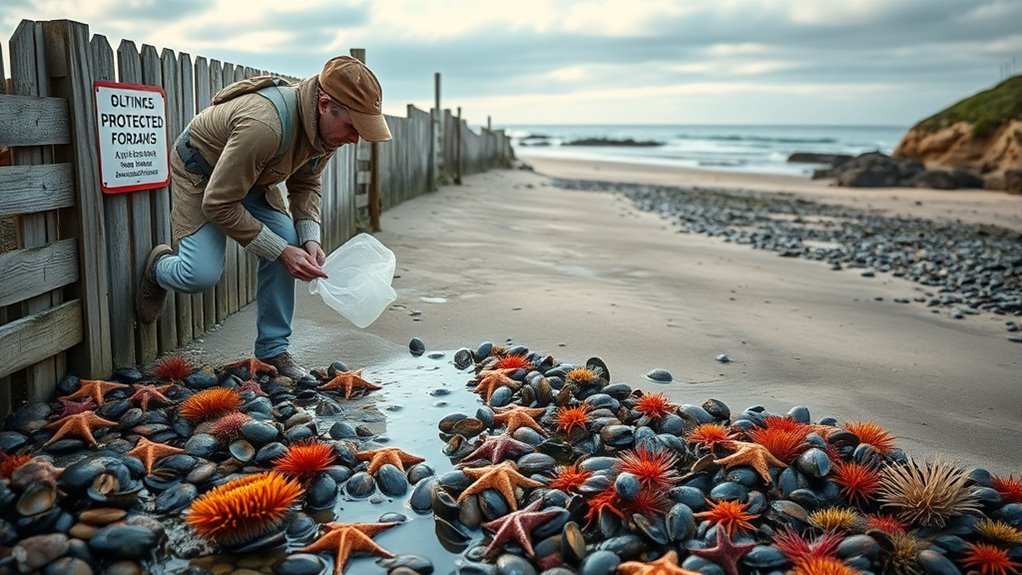
Traveling through private property and protected areas requires careful attention to legal and ethical considerations. Always seek explicit permissions from landowners before foraging on private property to respect their rights and avoid legal issues. Avoid foraging in protected areas such as national parks, wildlife refuges, and conservation zones, where collection is often prohibited by law. Familiarize yourself with signs and local regulations that mark restricted or protected zones to prevent unintentional trespassing. Be responsible foraging by respecting land boundaries and cultural signs, and minimize disturbance to habitats and wildlife. Leaving no trace helps maintain good relationships with landowners and conservation authorities. Prioritizing responsible stewardship to ensure your coastal foraging remains sustainable and respectful of both private property and protected areas is essential. Understanding local foraging regulations is essential for ethical harvesting practices. Staying informed about regulatory frameworks can also help you navigate complex legal landscapes and avoid potential conflicts. Always adhere to ethical foraging principles to promote conservation and sustainability in your foraging practices.
Understanding Local Regulations and Permits

Understanding local regulations and permits is essential before you start foraging along the coast, as rules can differ markedly depending on your location. Permitting may be required for collecting certain species like shellfish or seaweed, especially in states such as California and Maine. Regulations often restrict the quantity and types of marine life or plants you can harvest, promoting sustainable foraging practices. Many protected areas ban foraging altogether to safeguard native ecosystems and prevent habitat disturbance. To avoid fines or legal issues, always check with local wildlife or natural resource agencies before you begin harvesting. Being informed about harvesting laws ensures you stay compliant and respect the environment, helping preserve coastal ecosystems for future generations.
Recognizing and Protecting Sensitive Habitats
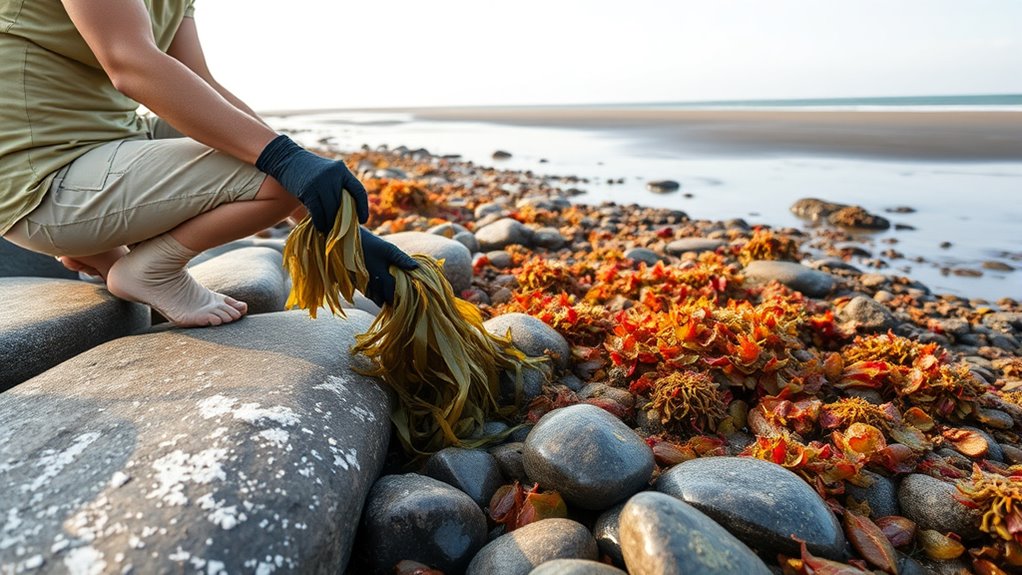
Recognizing and protecting sensitive coastal habitats is crucial for responsible foraging. These habitats, like salt marshes, dunes, and estuaries, host unique coastal ecosystems that need minimal disturbance to guarantee ecological preservation. To support habitat protection, avoid removing plants, shells, or other natural materials that are essential to habitat health. Be mindful of signs indicating sensitive areas, such as fragile dune systems or nesting sites, and steer clear to prevent habitat disturbance. Access to protected zones often requires permits or adherence to regulations, so always check local guidelines. Trampling delicate vegetation or soil can cause erosion and harm wildlife. By respecting these sensitive habitats, you help sustain biodiversity and contribute to the long-term health of coastal ecosystems.
Practicing Mindful Collection and Leave No Trace

When foraging, focus on collecting only what you need and no more than 5-10% of a plant or population to keep ecosystems healthy. Use gentle techniques that cause minimal disturbance, like clipping just parts of plants and leaving roots intact. Always respect protected areas by leaving ecosystems untouched and packing out all trash to ensure nature stays vibrant for others.
Harvest Responsibly Always
Practicing mindful collection and leaving no trace are essential when foraging to guarantee sustainability and protect ecosystems. When harvesting wild plants, stick to foraging ethics by taking no more than 5% of a plant or population, ensuring future growth. Use scissors or knives to collect only what’s needed, leaving roots and reproductive parts like flowers and seeds intact to support plant conservation. Avoid trampling vegetation by sticking to designated paths, which minimizes soil compaction and damage. Always follow leave no trace principles by packing out all trash and respecting wildlife and private land boundaries. These practices promote sustainable foraging, help maintain healthy ecosystems, and ensure that coastal resources remain abundant for everyone to enjoy responsibly.
Respect Protected Areas
To truly respect protected coastal areas, you need to follow local regulations and guidelines carefully. Always research rules about foraging etiquette in these zones, as many parks prohibit collection without permission. Practice habitat preservation by minimizing disturbance, avoiding trampling vegetation, and packing out all waste. Use gentle collection methods like scissors or hand-picking to prevent ecosystem damage. Respect signage and boundaries marking protected zones, and seek advice from authorities when unsure. Remember, sustainable harvesting means taking only what you need, ensuring native populations and habitats stay healthy for future foragers.
| Zone Type | Allowed Actions | Restrictions |
|---|---|---|
| Nature Reserves | Observe and document | No collection without permission |
| Marine Parks | Limited sustainable harvesting | Avoid damaging habitats |
| Protected Shores | Follow signage and boundaries | No disturbance or waste |
| Conservation Areas | Seek guidance from authorities | Limit harvest quantities |
| Wildlife Zones | Keep disturbance minimal | No removal of native species |
Leave Ecosystems Intact
Leaving ecosystems intact while foraging is essential to guarantee their long-term health and resilience. By practicing sustainable harvesting, you ensure only 5-10% of a plant population is collected, allowing natural regeneration. Use minimal disturbance techniques, such as hand-picking or careful cutting, to prevent trampling native plants and causing soil erosion. Always leave behind flowers, seeds, and reproductive parts to support ongoing plant health and future growth. Avoid collecting from fragile ecosystems like salt marshes, dunes, or tide pools to preserve delicate habitats. Carry out all trash, leftover plant material, and tools to maintain habitat preservation and keep the environment pristine. Mindful collection helps protect ecosystems, ensuring they remain vibrant and productive for future generations.
Building Community and Sharing Knowledge

Building community and sharing knowledge are essential for sustainable foraging. When you join local groups or workshops, you learn from others’ experiences, promoting ethical harvesting and sustainable practices. Sharing harvests and tips strengthens bonds and encourages responsible foraging in coastal areas. Engaging with Indigenous and local experts ensures culturally respectful and ecologically sound practices. Participating in community-led conservation efforts helps protect fragile habitats from overharvesting. Using online platforms and social media allows you to exchange info widely, raising awareness and fostering responsible behaviors.
| Benefits of Building Community | Ways to Share Knowledge |
|---|---|
| Collective stewardship | Joining workshops and groups |
| Cultural respect | Connecting with Indigenous experts |
| Habitat protection | Using social media for info exchange |
Frequently Asked Questions
What Are the Ethics of Foraging?
When you forage, you should prioritize ethics by accurately identifying plants and respecting laws. Take only what you need, usually 5-10%, to protect the ecosystem. Always ask permission on private land and avoid protected areas. Be mindful of endangered or culturally important species, and give back to the land through reseeding or leaving some plants untouched. These practices help preserve biodiversity and maintain ecological balance.
How to Forage Respectfully?
Think of foraging as tending a delicate garden—your actions shape its future. You should always get permission before harvesting, so you don’t trample on others’ rights. Only take what you need, like harvesting a few ripe fruits, to keep the ecosystem healthy. Stay on designated paths, avoid damaging plants, and follow local rules. Respectful foraging guarantees these treasures remain for everyone today and tomorrow.
What Is the Golden Rule of Foraging?
The Golden Rule of foraging is about treating nature with respect and care. You should only take what you need, leaving enough for the plants to grow back and wildlife to thrive. Always seek permission if you’re on private land, follow local rules, and make certain you’re sure of what you’re harvesting. By doing this, you help keep the environment healthy and ensure future foraging opportunities.
What Is the Rule of Three Foraging?
The Rule of Three Foraging guides you to harvest only a third of a plant’s parts, like leaves, flowers, or stems. This approach helps you gather what you need without harming the plant or its environment. By taking only a small portion, you support sustainable foraging, protect plant populations, and give the ecosystem a chance to thrive. It’s a mindful way to enjoy nature responsibly.
Conclusion
So, next time you head to the coast, remember that your foraging choices could be the difference between thriving ecosystems or silent shores. Ironically, by respecting the rules and practicing responsible harvesting, you actually help guarantee these treasures remain for everyone — including future foragers. It’s a small effort with a big impact, proving that sometimes, the best way to take is by knowing when to leave. After all, nature’s generosity relies on your mindful stewardship.


